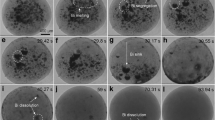Abstract
In situ transmission electron microscopy is used to study dissolution of liquid single-phase Pb/Bi inclusions attached to a grain boundary in an alloy of Al99.29Pb0.65Bi0.06 at temperatures of 343, 370, and 389 °C, respectively. The initial size of the inclusions was smaller than 60 nm. Dissolution of the inclusions was observed until their complete disappearance. Digitized video recordings of the process of dissolution were used to obtain the dependence of the inclusion size with time. The kinetics of the dissolution of the grain boundary inclusions can be described with a model where it is assumed that grain-boundary diffusion of Pb and Bi is the controlling mechanism. The high value (2.3 eV) of the apparent activation enthalpy of dissolution indicates that the process is likely governed by the large negative enthalpies of solubility of Pb and Bi in Al.





Similar content being viewed by others
Notes
It can be written that \({{{c_{\rm b}^{\rm sat}}/{c^{\rm sat}}} = ( {{c_{\rm bo}^{\rm sat}}/{c_{\rm o}^{\rm sat}}}) \exp [( {\Updelta H_{\rm b}^{\rm sol}-\Updelta H^{\rm sol}})/ RT }]\), where \(\Updelta H^{\rm sol}_{\rm b} \) and \(\Updelta H^{{{\text{sol}}}}\) are the solute solubility enthalpies in grain-boundary and bulk solutions, respectively. The chemical potentials of the same component atoms in saturated bulk and grain-boundary solutions, which are in equilibrium are related as \({\mu^{{{\text{sat}}}}_{{\text{b}}}} = {\mu^{{{\text{sat}}}}} + {\bar A_{{{\text{sol}}}} \gamma ^{{{\text{sat}}}}_{{\text{b}}}},\) where \(\bar A_{{{\text{sol}}}}\) is the partial molar area of solute in grain boundary, and \(\gamma^{\rm sat}_{\rm b}\) (0.3 J/m) is the surface tension of a grain boundary saturated with the solute. Then, one can show that \({\Updelta H ^{{{\text{sol}}}}_{{\text{b}}}} - {\Updelta H ^{{{\text{sol}}}}} = {\bar A_{{{\text{sol}}}}\gamma ^{{{\text{sat}}}}_{{\text{b}}}} \cong {\Upomega_{\rm matr} \gamma ^{{{\text{sat}}}}_{{\text{b}}}} / \delta\, {\approx}\,10 \,{\rm kJ/mol} \ll {\Updelta H ^{{{\text{sol}}}}},\) where \(\delta\) (0.5 ⋅ 10−9 m) is the width of a grain boundary. Indeed, when the solute solubility in a grain boundary is restricted, the partial molar area can be defined as \(\bar A_{\rm sol} = A _{\rm m} + (1 - X_{\rm b}) \partial A_{\rm m} / \partial X_{\rm b},\) where \(A_{\rm m} = \Upomega_{\rm m}/\delta = [\Upomega_{\rm matr}(1-c_{\rm b}) + \Upomega_{\rm sol}c_{\rm b}]/\delta\) is the molar grain boundary area, \(X_{\rm b} = c_{\rm b}/c^{\rm sat}_{\rm b}\), \(\Upomega_{\rm matr}\) (2 ⋅ 10−5 m3) and \(\Upomega_{\rm sol}\) are the molar volumes of matrix and solute atoms, respectively. So, one can show that \(\bar A_{\rm sol} = [\Upomega_{\rm matr} (1-c^{\rm sat}_{\rm b}) + c^{\rm sat}_{\rm b} \Upomega_{\rm sol}]/\delta \,\cong\, \Upomega_{\rm matr} / \delta \, {\rm if} \,c^{\rm sat}_{\rm b} \ll 1\).
References
Geguzin YaE, Krivoglaz MA (1973) Migration of macroscopic inclusions in solids. Consultants Bureau, New York
Ashby MF (1980) Recrystallization and grain growth of multi-phase and particle containing materials. In: Hansen N, Jones AR, Leffers T (eds) First Risø international symposium on metallurgy and materials science, Risø National Laboratory, Roskilde, p 325
Gottstein G, Shvindlerman LS (1999) Grain boundary migration in metals. CRC Press, Boca Raton
Speight MV (1968) Acta Metall 16:133
Ardell AJ (1972) Acta Metall 20:601
Butler EP, Swann PR (1976) Acta Metall 24:343
Czurratis P, Kroggel P, Löffler H (1988) Z Metallkd 79:307
Fujii T, Moriyama M, Kato M, Mori T (1993) Philos Mag 68:137
Monzen R, Hasegawa T (1997) Philos Mag Lett 76:69
Lifshitz IM, Slyozov VV (1961) J Phys Chem Solids 19:35
Wagner C (1961) Z Electrochem 65:581
Kreye H (1970) Z Metallkd 61:108
Sun W (2005) Acta Mater 53:3329
Massalski TB (Ed.-in-Chief) (1986) Binary alloy phase diagrams, vol 1. ASM, Metals Park, OH, pp 96, 147, 524
Gabrisch H, Kjeldgaard L, Johnson E, Dahmen U (2001) Acta Mater 49:4259
Gabrisch H, Dahmen U, Johnson E (1998) Microsc Res Tech 42:241
Kaur I, Gust W (1988) Fundamentals of grain and interphase boundary diffusion. Ziegler, Stuttgart
Wolverton C, Ozolinš V (2006) Phys Rev B73:144104
Acknowledgements
The work was supported by the Russian Foundation for Basic Research (Project 05-03-33141), the Danish Natural Science Research Council, and the Director, Office of Basic Energy Sciences, Materials Science Division, US Department of Energy, under contract DE-AC3-76SF00098. We are grateful to P. Ochin and his group (CNRS-CECM) for providing the rapidly solidified ribbons.
Author information
Authors and Affiliations
Corresponding author
Rights and permissions
About this article
Cite this article
Prokofjev, S.I., Johnson, E., Zhilin, V.M. et al. Dissolution kinetics of nanoscale liquid Pb/Bi inclusions at a grain boundary in aluminum. J Mater Sci 43, 3894–3899 (2008). https://doi.org/10.1007/s10853-007-2409-9
Received:
Accepted:
Published:
Issue Date:
DOI: https://doi.org/10.1007/s10853-007-2409-9




